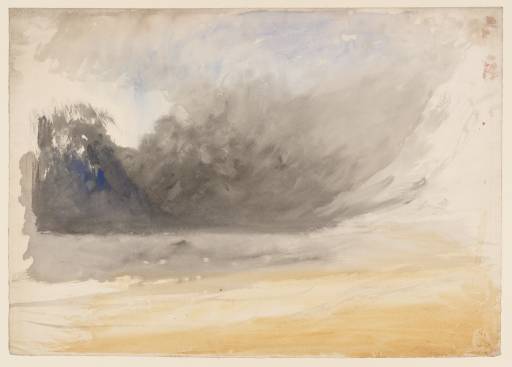Joseph Mallord William Turner ?Criccieth Castle c.1836
Joseph Mallord William Turner,
?Criccieth Castle
c.1836
Joseph Mallord William Turner 1775–1851
?Criccieth Castle c.1836
D25161
Turner Bequest CCLXIII 39
Turner Bequest CCLXIII 39
Watercolour on white wove paper, 344 x 481 mm
Inscribed in red ink ‘39’ bottom right
Blind-stamped with Turner Bequest monogram towards bottom right
Stamped in black ‘CCLXIII – 39’ bottom right
Inscribed in red ink ‘39’ bottom right
Blind-stamped with Turner Bequest monogram towards bottom right
Stamped in black ‘CCLXIII – 39’ bottom right
Accepted by the nation as part of the Turner Bequest 1856
Exhibition history
2002
Turner: Reflections of Sea and Light: Paintings and Watercolors by J.M.W. Turner from Tate, Baltimore Museum of Art, February–May 2002 (no catalogue).
2002
Turner y el mar: Acuarelas de la Tate, Fundación Juan March Madrid, September 2002–January 2003 (48, reproduced in colour, as ‘Marejada en la costa, cielo tormentoso’, c.1825–30).
2003
O mar e a luz: Aguarelas de Turner na colecção da Tate, Museu Calouste Gulbenkian, Lisbon, February–May 2003 (50, reproduced in colour, as ‘Breakers on Coast, Stormy Sky, c.1825–30).
References
1909
A.J. Finberg, A Complete Inventory of the Drawings of the Turner Bequest, London 1909, vol.II, p.817, CCLXIII 39, as ‘Breakers on coast: stormy effect’. c.1820–30.
1997
Eric Shanes, Turner’s Watercolour Explorations 1810–1842, exhibition catalogue, Tate Gallery, London 1997, pp.30, 94, 95, 100, 101, 104 (p.94 Appendix I under ‘Criccieth Castle’, p.95 under ‘England and Wales Series’, as ‘?Related to Crickieth Castle, North Wales’. c.1836, p.100 under ‘Oil Paintings?’, as ‘?Related to Life-Boat and Manby Apparatus, RA 1831’, p.101 under ‘Sea Sketches and Studies’, p.104 Appendix II, as ‘Study: ?Criccieth Castle, North Wales/Life-Boat and Manby Apparatus’).
This is one of four colour studies linked by Eric Shanes with varying degrees of certainty to the watercolour of about 1836 showing the castle at Criccieth, near Porthmadog, Gwynedd, on its headland looking overlooking Tremadog Bay to the south (British Museum, London);1 it was engraved as Crickieth [sic] Castle, North Wales in 1837 for the Picturesque Views in England and Wales (Tate impressions: T04610, T06126).2 The others are Tate D25170, D25174 and D25293 (Turner Bequest CCLXIII 48, 52, 171). Of three pencil sketches of Criccieth in the 1798 North Wales sketchbook (Tate D01378–D01380; Turner Bequest XXXIX 23, 24, 25), D01379 is closest to the finished watercolour, though with considerable differences.
If this is a preliminary idea for a Criccieth view, it is a major variation: the developed design shows the castle and its headland on the skyline in the left-hand half of the composition, bright against a stormy sky, whereas here there is the pale form of what appears to be a cliff of steep hillside towards the far right. Despite Shanes’s suggestion, it has continued to be exhibited with titles derived from Finberg’s ‘Breakers on coast: stormy effect’. Shanes also compared the present work3 to the oil painting Life-Boat and Manby Apparatus Going Off to a Stranded Vessel Making Signal (Blue Lights) of Distress, exhibited at the Royal Academy in 1831 (Victoria and Albert Museum, London),4 with its billowing dark clouds to the left and clearer sky to the right over the level horizon of sea and beach.
See also Tate D25176 (Turner Bequest CCLXIII 54), which Finberg thought possibly showed Criccieth, but which may be of Conway Castle, the introductions to the present subsection of identified subjects and the overall England and Wales ‘colour beginnings’ grouping to which this work has been assigned.
Verso:
Blank; inscribed in pencil ‘13’ centre right, upside down; inscribed in pencil ‘AB 92 P | O’, ‘CCLXIII.39’ and ‘D25161’ bottom right; stamped in black with Turner Bequest monogram above ‘CCLXIII – 39’ bottom left.
Blank; inscribed in pencil ‘13’ centre right, upside down; inscribed in pencil ‘AB 92 P | O’, ‘CCLXIII.39’ and ‘D25161’ bottom right; stamped in black with Turner Bequest monogram above ‘CCLXIII – 39’ bottom left.
The ‘AB’ number corresponds with the endorsement on one of the parcels of works sorted by John Ruskin during his survey of the Turner Bequest, in this case classified by him as ‘Colour effects. Valueless’.1
Matthew Imms
March 2013
How to cite
Matthew Imms, ‘?Criccieth Castle c.1836 by Joseph Mallord William Turner’, catalogue entry, March 2013, in David Blayney Brown (ed.), J.M.W. Turner: Sketchbooks, Drawings and Watercolours, Tate Research Publication, December 2013, https://www

